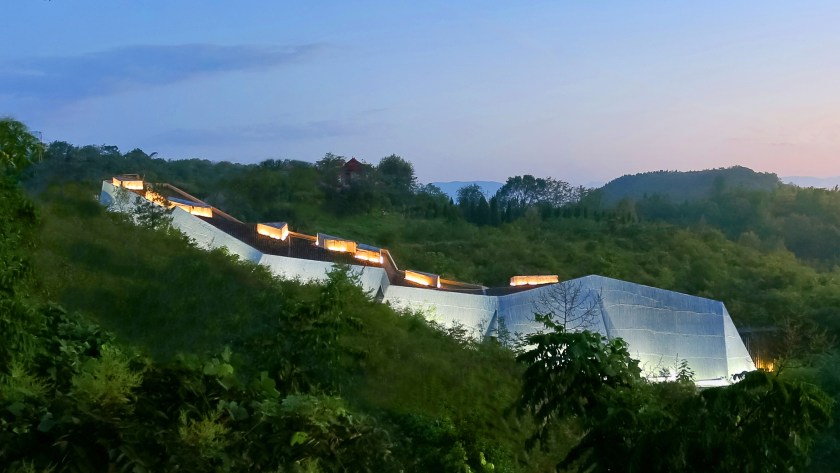
A new museum in China, exhibiting fossils of eggs laid 80 million years ago, is surprisingly contemporary for an institution protecting such ancient wonders. Showcasing one of the country’s most prized archeological sites, the Dinosaur Egg Geological Museum in Qinglong Mountain Geopark blends old and new with its design, materials, and even its construction.
Literally built around the dino eggs, a team of architects from Huazhong University of Science and Technology (Wuhan HST)—led by Li Baofeng, Jianmin Ding and Changshun Xu—designed the museum to create the least amount of environmental disturbance possible. The Wuhan HUST architects broke up the 230-foot-long structure in chunks, adapting it for the mountainous terrain.
Painstakingly avoiding major excavation, large rocks from local rivers and creeks were used to support the foundation of the museum. “It is a building that is modest to the site, honest to the history and respectful to the archaeological excavation,” the architects said in a press release. “The unaltered natural field and 800-year-old ancient trees are the main landscape features, which echoes the natural and minimalistic design principles of the architecture.”
For the Wuhan HUST team, environmental considerations were the priority for the project given its scientific value, so only locally-sourced materials were used in construction. The exterior features bamboo-textured walls, made by molding cast-in-place over repurposed scaffolding. Incorporating the traditional materials is an innovative way to create the geometric space while still paying homage to curving roof tiles used on old buildings in China.
While these particular eggs were discovered in 1995, dinosaur fossils are found fairly often during excavation or construction in Hubei Province. Each section of the museum is clustered around a nesting site, which is spotlighted by a skylight above it. The dimly-lit spaces are simple, only featuring a footbridge to give visitors a better perspective to view the fossils. Connecting each section are light-blocking grills that naturally ventilate the building. Also helping to cool the museum during hot summers is a roof built with an additional exterior layer of recycled tiles from derelict homes nearby. The two layers enable air circulation, reducing the temperature of the roof.
See more images from the innovative design below.
This article was featured in the InsideHook newsletter. Sign up now.